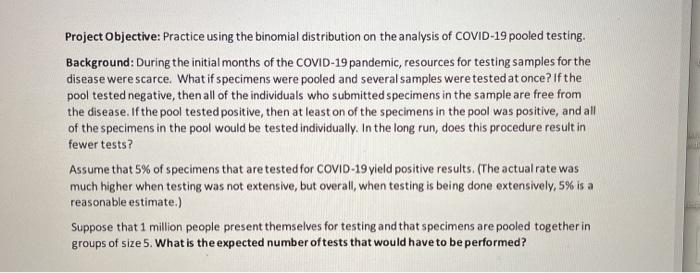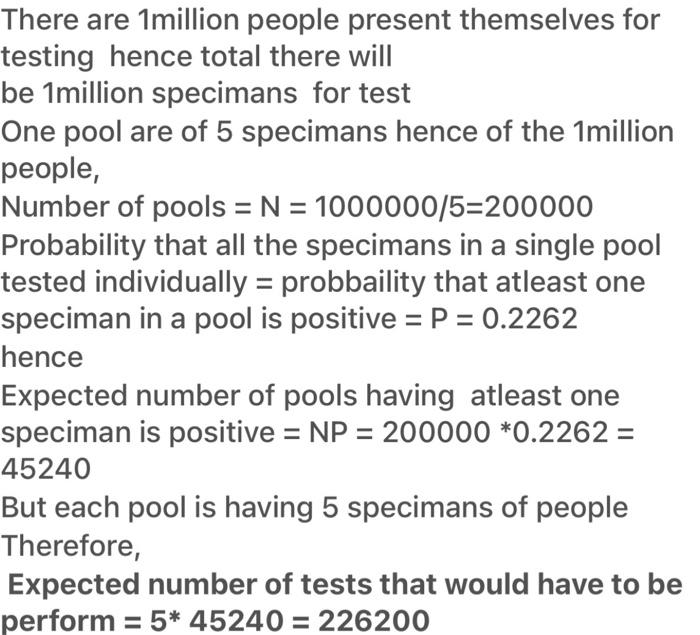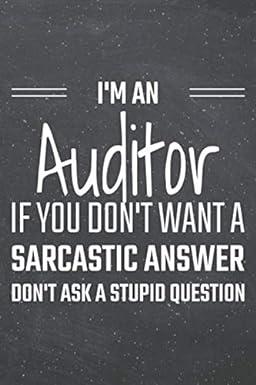Based on the data and solving the first, second and third questions, answer the fourth question

Project Objective: Practice using the binomial distribution on the analysis of COVID-19 pooled testing. Background: During the initial months of the COVID-19 pandemic, resources for testing samples for the disease were scarce. What if specimens were pooled and several samples were tested at once? If the pool tested negative, then all of the individuals who submitted specimens in the sample are free from the disease. If the pool tested positive, then at least on of the specimens in the pool was positive, and all of the specimens in the pool would be tested individually. In the long run, does this procedure result in fewer tests? Assume that 5% of specimens that are tested for COVID-19 yield positive results. (The actual rate was much higher when testing was not extensive, but overall, when testing is being done extensively, 5% is a reasonable estimate) Suppose that 1 million people present themselves for testing and that specimens are pooled together in groups of size 5. What is the expected number oftests that would have to be performed? 1. Calculate the probability that a pool of five independent specimens yields a positive result by complete the following questions. a. Why this procedure results in a binomial distribution? This procedure will result in a binomial distribution because there are only two possible outcomes, the number of outcomes is fixed (1,000,000), both observations are independent, and each outcome has the same probability. b. Identify the values of n, x, p. 4. n= Number of specimens in a group: 5 x = Number of specimens yielding a positive test p = Probability of specimen yielding a positive test: 0.05 q = Probability of specimen yielding a negative test: 1 -P (1-0.05) = 0.95 c. Calculate the probability that a pool of five independent specimens yields a positive result. Show work. Probability of at least one of the pools of five resulting in positive: P(x>=1) = 0.2262 1- P(x-0) - 0.7738 2. If 1 million specimens presented for testing are pooled into groups of five specimens each, how many of the 200,000 pools would you expect to be positive? There are 200,000 tests that must be performed. 1,000,000/5200,000 a. Why this procedure results in a binomial distribution? The trial must result in a success or a failure, hence we are considering positive or negative results. The probability of success should remain constant for any trial, here in this case it is 5% for the probability of success. b. Identify the values of n and p. The value of n = 5. The value of p=0.05 or 5% n=5 p=0.05 c. Find the expected value of pools to be positive. Show work, The expected value of pools to be positive is np= 5*0.05 -0.25 Question 3. Refer to the Background information above and calculate the totalexpected number of tests that would have to be performed. Show work. There are 1million people present themselves for testing hence total there will be 1million specimans for test One pool are of 5 specimans hence of the 1million people, Number of pools = N = 1000000/5=200000 Probability that all the specimans in a single pool tested individually = probbaility that atleast one speciman in a pool is positive = P = 0.2262 hence Expected number of pools having atleast one speciman is positive = NP = 200000 *0.2262 = 45240 But each pool is having 5 specimans of people Therefore, Expected number of tests that would have to be perform = 5* 45240 = 226200 Question 4. Calculate the total expected number of tests that would have to be performed if the size of the pool was 10 instead of 5. You only need to calculate the probability of positive in a pool, the expected number of positive pools, and the total number of tests need to be performed. Show work












